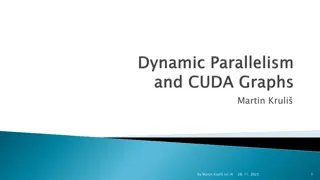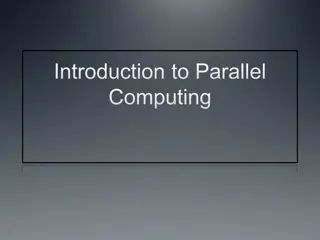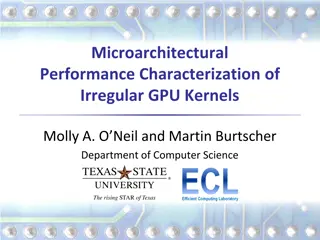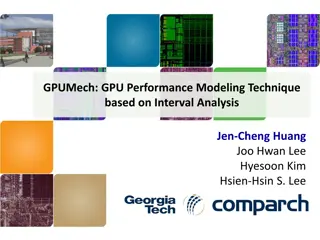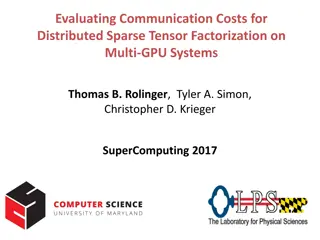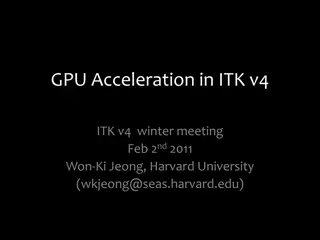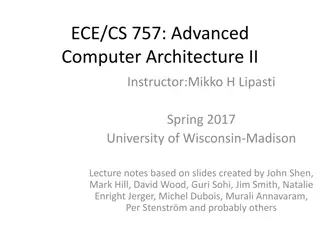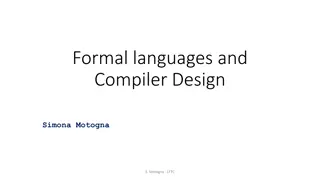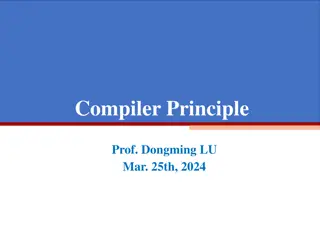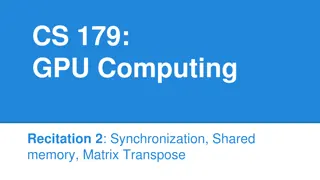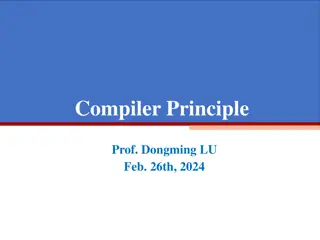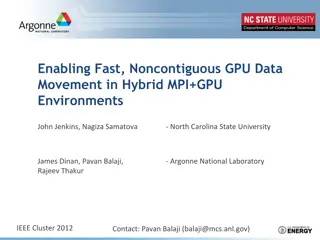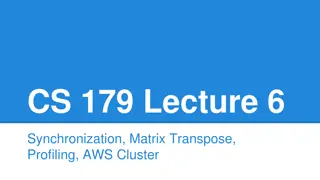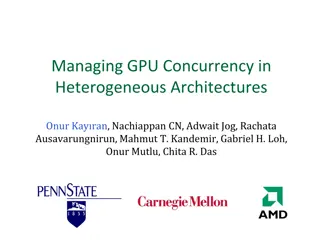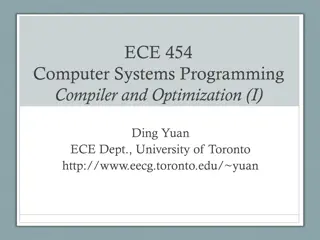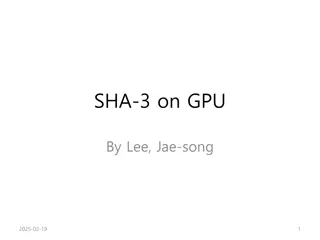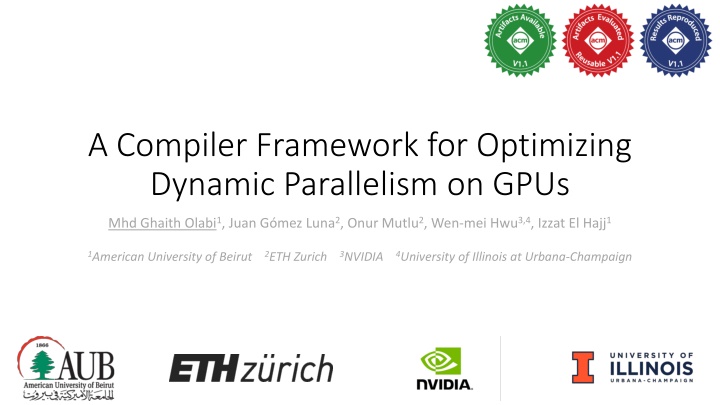
Compiler Framework for Optimizing Dynamic Parallelism on GPUs
Explore a compiler framework for optimizing dynamic parallelism on GPUs, enabling GPU threads to launch other grids, with insights on overcoming dynamic parallelism overhead and aggregation optimization. Prior work in this area is also discussed, showcasing various strategies to enhance performance and resource utilization.
Download Presentation

Please find below an Image/Link to download the presentation.
The content on the website is provided AS IS for your information and personal use only. It may not be sold, licensed, or shared on other websites without obtaining consent from the author. If you encounter any issues during the download, it is possible that the publisher has removed the file from their server.
You are allowed to download the files provided on this website for personal or commercial use, subject to the condition that they are used lawfully. All files are the property of their respective owners.
The content on the website is provided AS IS for your information and personal use only. It may not be sold, licensed, or shared on other websites without obtaining consent from the author.
E N D
Presentation Transcript
A Compiler Framework for Optimizing Dynamic Parallelism on GPUs Mhd Ghaith Olabi1, Juan G mez Luna2, Onur Mutlu2, Wen-mei Hwu3,4, Izzat El Hajj1 1American University of Beirut 2ETH Zurich 3NVIDIA 4University of Illinois at Urbana-Champaign
Dynamic Parallelism on GPUs Dynamic parallelism enables executing GPU threads to launch other grids of threads Parent threads Dynamic launch Parameters and launch configurations Child grids Useful for implementing computations with nested parallelism
Dynamic Parallelism Overhead Using dynamic parallelism may cause many small grids to be launched Launching many small grids causes performance degradation due to: Congestion Limited number of grids can execute simultaneously (others need to wait) Hardware underutilization If grids are small, their may not be enough threads launched to fully utilize hardware resources Solution: launch fewer grids of larger sizes
Prior Work: Aggregation Aggregation is an optimization where: Multiple child grids are consolidated into a single aggregated grid One parent thread launches the aggregated grid on behalf of the rest I. El Hajj, J. Gomez-Luna, C. Li, L.-W. Chang, D. Milojicic, and W.-m. Hwu, KLAP: Kernel launch aggregation and promotion for optimizing dynamic parallelism, in Microarchitecture (MICRO), 2016 49th Annual IEEE/ACM International Symposium on. IEEE, 2016, pp. 1 12 D. Li, H. Wu, and M. Becchi, Exploiting dynamic parallelism to efficiently support irregular nested loops on GPUs, in Proceedings of the 2015 International Workshop on Code Optimisation for Multi and Many Cores. ACM, 2015, p. 5. Li, D., Wu, H., & Becchi, M., Nested parallelism on GPU: Exploring parallelization templates for irregular loops and recursive computations, in Parallel Processing (ICPP), 2015 44th International Conference on. IEEE, 2015, pp. 979 988. H. Wu, D. Li, and M. Becchi, Compiler-assisted workload consolidation for efficient dynamic parallelism on GPU, arXiv preprint arXiv:1606.08150, 2016.
Prior Work: Aggregation Aggregation is an optimization where: Multiple child grids are consolidated into a single aggregated grid One parent thread launches the aggregated grid on behalf of the rest Memory access In memory Aggregated child grid + Reduces congestion by reducing the number of launched grids + Improves utilization because aggregated child grids have more threads then original ones
Contributions Thresholding (as a compiler optimization) Prior work relies on programmers to apply it manually Coarsening of child thread blocks Prior work on compiler-based coarsening not specialized for dynamic parallelism Aggregation of child grids at multi-block granularity Prior work only compiler-based aggregation only considers warp, block, and grid granularity One compiler framework that combined the three optimizations
Thresholding Thresholding is an optimization where: A grid is launched dynamically only if the number of child threads exceeds a certain threshold Otherwise, work is executed sequentially by the parent thread
Thresholding Thresholding is an optimization where: A grid is launched dynamically only if the number of child threads exceeds a certain threshold Otherwise, work is executed sequentially by the parent thread Child thread serialized in parent thread + Reduces congestion by reducing the number of launched grids + Improves utilization by only allowing grids with many threads to be launched
Coarsening Coarsening is a transformation where: The work of multiple child blocks is assigned to a single child block
Coarsening Coarsening is a transformation where: The work of multiple child blocks is assigned to a single child block Original thread block before coarsening Coarsened child grids + When applied before aggregation, amortizes the cost of disaggregation (incurred once per child blocks)
Multi-block Granularity Aggregation Multi-block granularity aggregation is an optimization where: The child grids of multiple parent blocks are consolidated into a single aggregated grid
Multi-block Granularity Aggregation Multi-block granularity aggregation is an optimization where: The child grids of multiple parent blocks are consolidated into a single aggregated grid + Compared to block granularity, launches fewer and larger grids + Compared to grid granularity, launches child grids more eagerly
Overall Speedup 512 256 No CDP CDP KLAP (CDP+A) CDP+T CDP+C CDP+T+C CDP+T+A CDP+C+A CDP+T+C+A 128 64 32 Speedup over CDP 16 8 4 2 1 0.5 0.25 0.125 CNR CNR CNR RAND-3 CNR CNR T32-C16 KRON KRON KRON KRON KRON T2048-C64 5-SAT BFS BT MSTF MSTV SP SSSP TC Geomean We evaluate all combinations of optimizations for 7 benchmarks with 2 datasets each
Overall Speedup 512 256 No CDP CDP KLAP (CDP+A) CDP+T CDP+C CDP+T+C CDP+T+A CDP+C+A CDP+T+C+A 128 64 32 Speedup over CDP 16 8 4 2 1 0.5 0.25 0.125 CNR CNR CNR RAND-3 CNR CNR T32-C16 KRON KRON KRON KRON KRON T2048-C64 5-SAT BFS BT MSTF MSTV SP SSSP TC Geomean We report speedup (higher is better) over the baseline that uses CUDA dynamic parallelism (CDP)
Overall Speedup 512 256 No CDP CDP KLAP (CDP+A) CDP+T CDP+C CDP+T+C CDP+T+A CDP+C+A CDP+T+C+A 128 64 32 Speedup over CDP 16 8 4 2 1 0.5 0.25 0.125 CNR CNR CNR RAND-3 CNR CNR T32-C16 KRON KRON KRON KRON KRON T2048-C64 5-SAT BFS BT MSTF MSTV SP SSSP TC Geomean Observation #1:Not using CDP performs better than na ve CDP (same observation as prior work).
Overall Speedup 512 256 No CDP CDP KLAP (CDP+A) CDP+T CDP+C CDP+T+C CDP+T+A CDP+C+A CDP+T+C+A 128 64 32 Speedup over CDP 16 8 4 2 1 0.5 0.25 0.125 CNR CNR CNR RAND-3 CNR CNR T32-C16 KRON KRON KRON KRON KRON T2048-C64 5-SAT BFS BT MSTF MSTV SP SSSP TC Geomean Observation #2:Aggregation improves performance of na ve CDP (same observation as prior work). KLAP(CDP+A) is 12.1 faster than CDP on average (geomean).
Overall Speedup 512 256 No CDP CDP KLAP (CDP+A) CDP+T CDP+C CDP+T+C CDP+T+A CDP+C+A CDP+T+C+A 128 64 32 Speedup over CDP 16 8 4 2 1 0.5 0.25 0.125 CNR CNR CNR RAND-3 CNR CNR T32-C16 KRON KRON KRON KRON KRON T2048-C64 5-SAT BFS BT MSTF MSTV SP SSSP TC Geomean Observation #3:Thresholding alone improves the performance over CDP. CDP+T is 13.4 faster than CDP on average (geomean).
Overall Speedup 512 256 No CDP CDP KLAP (CDP+A) CDP+T CDP+C CDP+T+C CDP+T+A CDP+C+A CDP+T+C+A 128 64 32 Speedup over CDP 16 8 4 2 1 0.5 0.25 0.125 CNR CNR CNR RAND-3 CNR CNR T32-C16 KRON KRON KRON KRON KRON T2048-C64 5-SAT BFS BT MSTF MSTV SP SSSP TC Geomean Observation #4:Thresholding and Aggregation together improve the performance over CDP even more. Despite both targeting the same source of inefficiency, one optimization does not obviate the other.
Overall Speedup 512 256 No CDP CDP KLAP (CDP+A) CDP+T CDP+C CDP+T+C CDP+T+A CDP+C+A CDP+T+C+A 128 64 32 Speedup over CDP 16 8 4 2 1 0.5 0.25 0.125 CNR CNR CNR RAND-3 CNR CNR T32-C16 KRON KRON KRON KRON KRON T2048-C64 5-SAT BFS BT MSTF MSTV SP SSSP TC Geomean Observation #5:Coarsening alone does not improve performance substantially over CDP. CDP+C is 1.01 faster than CDP.
Overall Speedup 512 256 No CDP CDP KLAP (CDP+A) CDP+T CDP+C CDP+T+C CDP+T+A CDP+C+A CDP+T+C+A 128 64 32 Speedup over CDP 16 8 4 2 1 0.5 0.25 0.125 CNR CNR CNR RAND-3 CNR CNR T32-C16 KRON KRON KRON KRON KRON T2048-C64 5-SAT BFS BT MSTF MSTV SP SSSP TC Geomean Observation #6:Coarsening does improve performance when combined with the other optimizations. Recall: main benefit was amortizing overhead of aggregation. CDP+T+C+A is 1.22 faster than CDP+T+A.
Summary We present a compiler framework for optimizing the use of dynamic parallelism on GPUs in applications with nested parallelism The framework includes three key optimizations: Thresholding Coarsening Aggregation Our evaluation shows that our compiler framework substantially improves performance of applications with nested parallelism that use dynamic parallelism 43.0 faster than CDP. 8.7 faster than No CDP 3.6 faster than prior aggregation work (KLAP)
Thank you! Thank you! A Compiler Framework for Optimizing Dynamic Parallelism on GPUs Mhd Ghaith Olabi1, Juan G mez Luna2, Onur Mutlu2, Wen-mei Hwu3,4, Izzat El Hajj1 1American University of Beirut 2ETH Zurich 3NVIDIA 4University of Illinois at Urbana-Champaign Contact: moo02@mail.aub.edu

